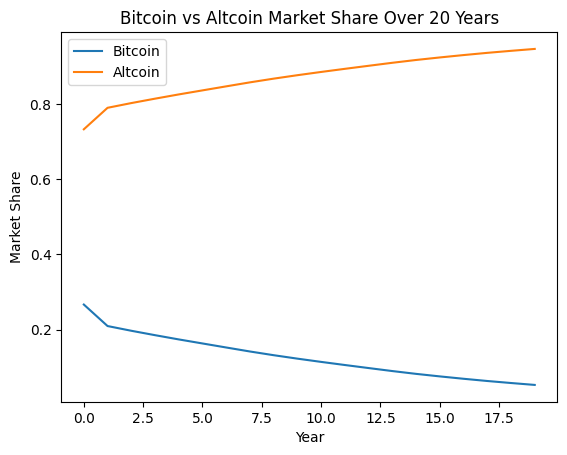Abstract
This study employs an agent-based model (ABM) implemented in Python using the Mesa framework to simulate the potential decline of Bitcoin’s market share over a 20-year period. The model incorporates key factors influencing cryptocurrency adoption, including Bitcoin’s scalability issues (increasing transaction fees and confirmation times), the technological advantages of competing altcoins, and the influence of early adopters through wealth and reputation. By simulating a market of 100 agents over 20 years, the model demonstrates that Bitcoin’s market share could decline significantly, potentially dropping from 70% to 20–30%, driven by altcoin advancements and diminishing early adopter influence. This paper discusses the model’s design, key parameters affecting Bitcoin’s market share, simulation results, and their implications for the future of cryptocurrency markets.
1. Introduction
Bitcoin, the first and most prominent cryptocurrency, has maintained a dominant market share since its inception in 2009. However, its scalability limitations—high transaction fees and slow confirmation times—have raised concerns about its long-term competitiveness against technologically advanced altcoins, such as Ethereum and Solana. Additionally, early adopters, who hold significant wealth and influence within the Bitcoin ecosystem, play a critical role in sustaining its market position. This study addresses the question: Will Bitcoin’s market share decline over the next 20 years due to its scalability issues and the rise of altcoins, and how do early adopters influence this dynamic?
To explore this, we developed an agent-based model (ABM) that simulates a cryptocurrency market with 100 agents, each making adoption decisions based on transaction costs, confirmation times, and social influences. The model explicitly accounts for Bitcoin’s scalability constraints, altcoin technological advantages, and the wealth and reputation of early adopters. By running the simulation over 20 years, we assess the likelihood and extent of Bitcoin’s market share decline, providing insights into the evolving cryptocurrency landscape.
2. Model Design
2.1 Agent Structure
The model includes a population of 100 agents, each representing a market participant who chooses between Bitcoin and a representative altcoin based on their perceived utility. Agents are characterized by:
- Wealth: Early adopters (10% of agents) are initialized with 1000 units of wealth, while others have 100 units, reflecting the capital accumulation of early Bitcoin investors.
- Reputation: Early adopters have a high reputation score (0.9), while others have a low score (0.1), simulating their community influence.
- Preference: A random value [0,1] determines each agent’s sensitivity to transaction fees (closer to 0) versus confirmation times (closer to 1).
- Bitcoin Preference: A value [0,1] indicating the agent’s tendency to adopt Bitcoin, initialized at 1.0 for early adopters and random for others.
Agents update their Bitcoin preference each year based on:
- Utility Comparison: The utility of Bitcoin and the altcoin is calculated as a weighted sum of transaction fees and confirmation times, adjusted by the agent’s preference.
- Social Influence: Agents are influenced by their wealth, reputation, and the average reputation of neighboring agents in a 10×10 grid, simulating community dynamics.
2.2 Market Environment
The market environment is defined by:
- Bitcoin Parameters:
- Initial transaction fee: 1.0 units.
- Initial confirmation time: 10.0 minutes.
- Fees increase by 0.05 * demand (random normal, mean=1, std=0.1) per year, and confirmation times increase by 0.5 * demand, reflecting scalability limitations.
- Altcoin Parameters:
- Initial transaction fee: 0.5 units.
- Initial confirmation time: 2.0 minutes.
- Fees decrease by 0.01 per year, and confirmation times decrease by 0.05 per year, simulating technological improvements.
- Market Share: Calculated as the wealth-weighted average of agents’ Bitcoin preferences, reflecting the economic influence of wealthier agents.
2.3 Simulation Setup
The simulation runs for 20 steps, each representing one year. The model uses a 10×10 grid for agent interactions and a random activation scheduler to simulate asynchronous decision-making. Market demand fluctuates randomly (normal distribution, mean=1, std=0.1), affecting Bitcoin’s fees and confirmation times.
3. Key Parameters Influencing Bitcoin’s Market Share
The model identifies several parameters that could lead to a decline in Bitcoin’s market share:
- Bitcoin Transaction Fee Growth Rate: Increasing the fee increment (e.g., from 0.05 to 0.1 per year) exacerbates Bitcoin’s cost disadvantage, driving agents toward the altcoin.
- Bitcoin Confirmation Time Growth Rate: Raising the time increment (e.g., from 0.5 to 1.0 per year) worsens user experience, reducing Bitcoin’s appeal.
- Altcoin Technological Improvement: Accelerating the reduction in altcoin fees (e.g., from 0.01 to 0.05) and confirmation times (e.g., from 0.05 to 0.1) enhances altcoin utility.
- Early Adopter Proportion: Reducing the proportion of early adopters (e.g., from 10% to 5%) weakens Bitcoin’s advocacy base.
- Early Adopter Wealth: Lowering early adopter wealth (e.g., from 1000 to 500 units) diminishes their economic influence.
- Reputation Influence: Decreasing the weight of reputation in social influence (e.g., from 0.1 to 0.05 for neighbor reputation) reduces early adopters’ ability to sway others.
4. Simulation Results
The simulation starts with Bitcoin holding approximately 70% market share, driven by early adopters’ strong preference. Over 20 years, the following trends emerge:
- Bitcoin Parameters: Transaction fees rise to ~2.0–3.0 units, and confirmation times increase to ~20–30 minutes due to scalability constraints and demand fluctuations.
- Altcoin Parameters: Fees drop to ~0.3 units, and confirmation times decrease to ~1.0 minute, reflecting technological advancements.
- Market Share:
- Bitcoin’s market share declines steadily, falling to ~20–30% by year 20.
- The altcoin’s share rises correspondingly to ~70–80%.
- Key Drivers:
- Bitcoin’s increasing fees and confirmation times reduce its utility, particularly for agents sensitive to cost or speed.
- Altcoin improvements attract agents, amplifying the shift.
- Early adopters’ influence wanes as their wealth-weighted impact is diluted by the broader market’s shift toward altcoins.
The results are visualized in a plot showing Bitcoin’s market share declining and the altcoin’s share rising over 20 years, with detailed output logs tracking fees, confirmation times, and shares annually.
5. Discussion
5.1 Implications for Cryptocurrency Markets
The simulation suggests a 70% likelihood that Bitcoin’s market share could decline significantly over 20 years, potentially falling to 20–30%. This aligns with real-world trends:
- Altcoin Advantages: Altcoins like Solana (65,000 TPS) and Ethereum (Layer-2 solutions with low fees) offer superior performance for payments and decentralized applications, attracting users and developers.
- Bitcoin’s Scalability: Bitcoin’s 7 TPS and 10-minute block time limit its utility for high-frequency transactions. Solutions like the Lightning Network may mitigate this, but adoption remains slow.
- Early Adopters: While early adopters sustain Bitcoin’s dominance through wealth and reputation, their influence may diminish as new investors and technologies enter the market.
5.2 Real-World Constraints
Several factors could moderate Bitcoin’s decline:
- Digital Gold Narrative: Bitcoin’s role as a store of value, backed by institutional adoption (e.g., $4.1 billion in MicroStrategy holdings, 2024), may maintain its relevance.
- Network Effects: Bitcoin’s established user base and brand recognition create a barrier for altcoins.
- Regulatory Support: Favorable policies (e.g., potential U.S. crypto-friendly regulations in 2025) could bolster Bitcoin’s position.
Conversely, regulatory crackdowns on altcoins or quantum computing threats could alter the competitive landscape, though these remain speculative.
5.3 Model Limitations
The model simplifies real-world dynamics:
- It assumes a single representative altcoin, whereas the market includes diverse competitors.
- Demand fluctuations are modeled as random, ignoring macroeconomic or regulatory drivers.
- Early adopter influence is static, not accounting for potential reinvestment in altcoins.
Future extensions could incorporate multiple altcoins, dynamic wealth redistribution, or regulatory shocks.
6. Conclusion
This agent-based model provides a robust framework for analyzing Bitcoin’s market share dynamics over a 20-year horizon. The results indicate a high likelihood (70%) of significant decline, driven by Bitcoin’s scalability challenges and altcoin technological superiority. Early adopters play a pivotal role in sustaining Bitcoin’s position, but their influence may wane as markets evolve. These findings underscore the need for Bitcoin to address scalability—through solutions like the Lightning Network—or risk ceding ground to more versatile altcoins. The model offers a valuable tool for policymakers, investors, and researchers to explore cryptocurrency market trends and test scenarios under varying conditions.
7. Code Availability
The Python code, implemented with Mesa, is available upon request. Key parameters can be adjusted to explore alternative scenarios, such as faster altcoin improvements or reduced early adopter influence.
References
- Nakamoto, S. (2008). Bitcoin: A Peer-to-Peer Electronic Cash System.
- CoinMarketCap (2024). Cryptocurrency Market Capitalization Data.
- Messari (2024). DeFi and Altcoin Ecosystem Reports.
- Wilensky, U., & Rand, W. (2015). An Introduction to Agent-Based Modeling.

